MITSUBISHI SHOGUN 2008 Owner's Manual (in English)
Manufacturer: MITSUBISHI, Model Year: 2008, Model line: SHOGUN, Model: MITSUBISHI SHOGUN 2008Pages: 538, PDF Size: 25.09 MB
Page 461 of 538
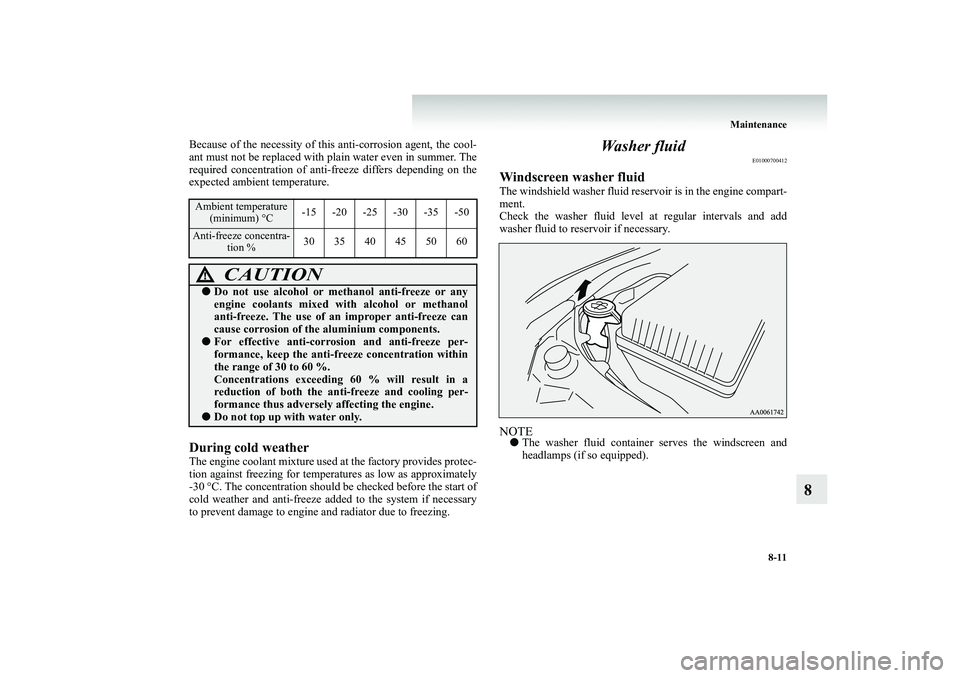
Maintenance
8-11
8
Because of the necessity of this
anti-corrosion agent, the cool-
ant must not be replaced with
plain water even in summer. The
required concentration of anti
-freeze differs depending on the
expected ambient temperature.During cold weatherThe engine coolant mixture used
at the factory provides protec-
tion against freezing for temperat
ures as low as approximately
-30 °C. The concentration should
be checked before the start of
cold weather and anti-freeze adde
d to the system if necessary
to prevent damage to engine
and radiator due to freezing.
Wa s h e r f l u i d
E01000700412
Windscreen washer fluidThe windshield washer fluid reservoir is in the engine compart- ment. Check the washer fluid level
at regular intervals and add
washer fluid to reservoir if necessary.NOTE●
The washer fluid container
serves the windscreen and
headlamps (if so equipped).
Ambient temperature
(minimum) °C
-15 -20 -25 -30 -35 -50
Anti-freeze concentra-
tion %
30 35 40 45 50 60
CAUTION
!●
Do not use alcohol or me
thanol anti-freeze or any
engine coolants mixed with alcohol or methanolanti-freeze. The use of an improper anti-freeze can cause corrosion of the
aluminium components.
●
For effective anti-corro
sion and anti-freeze per-
formance, keep the anti-f
reeze concentration within
the range of 30 to 60 %. Concentrations
exceeding 60 % will result in a
reduction of both the an
ti-freeze and cooling per-
formance thus adversely
affecting the engine.
●
Do not top up with water only.
BK-BK2008E1ENUK.en-uk-Section11.fm Page
11 Wednesday, January 9, 2008 4:50 PM
Page 462 of 538
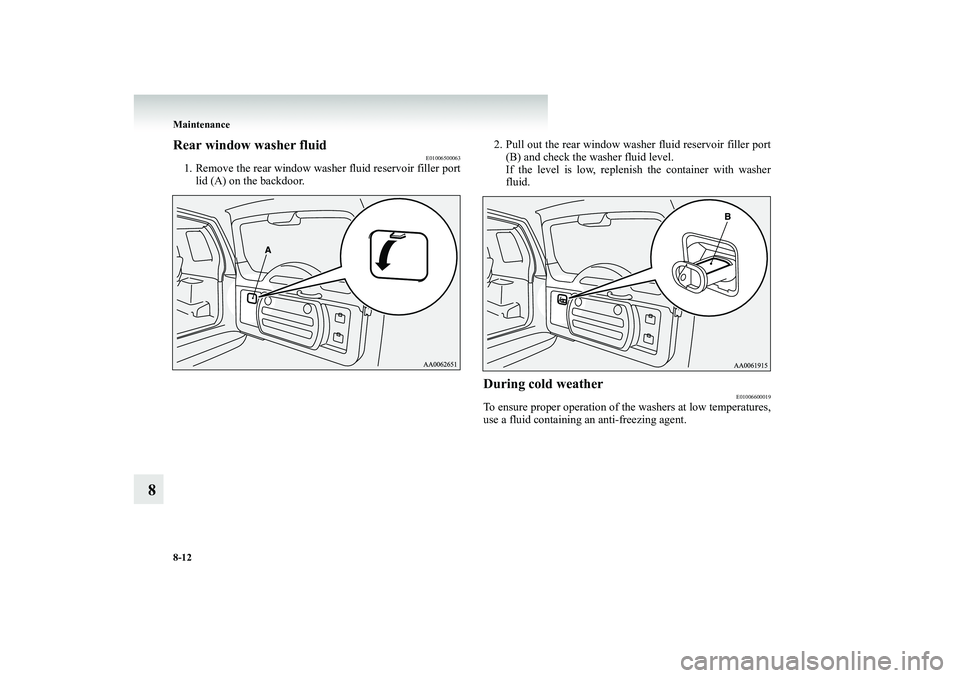
8-12 Maintenance
8
Rear window washer fluid
E01006500063
1. Remove the rear window washer fluid reservoir filler port
lid (A) on the backdoor.
2. Pull out the rear window washer fluid reservoir filler port
(B) and check the washer fluid level. If the level is low, replenish the container with washer fluid.
During cold weather
E01006600019
To ensure proper operation of th
e washers at low temperatures,
use a fluid containing
an anti-freez
ing agent.
BK-BK2008E1ENUK.en-uk-Section11.fm Page
12 Wednesday, January 9, 2008 4:50 PM
Page 463 of 538
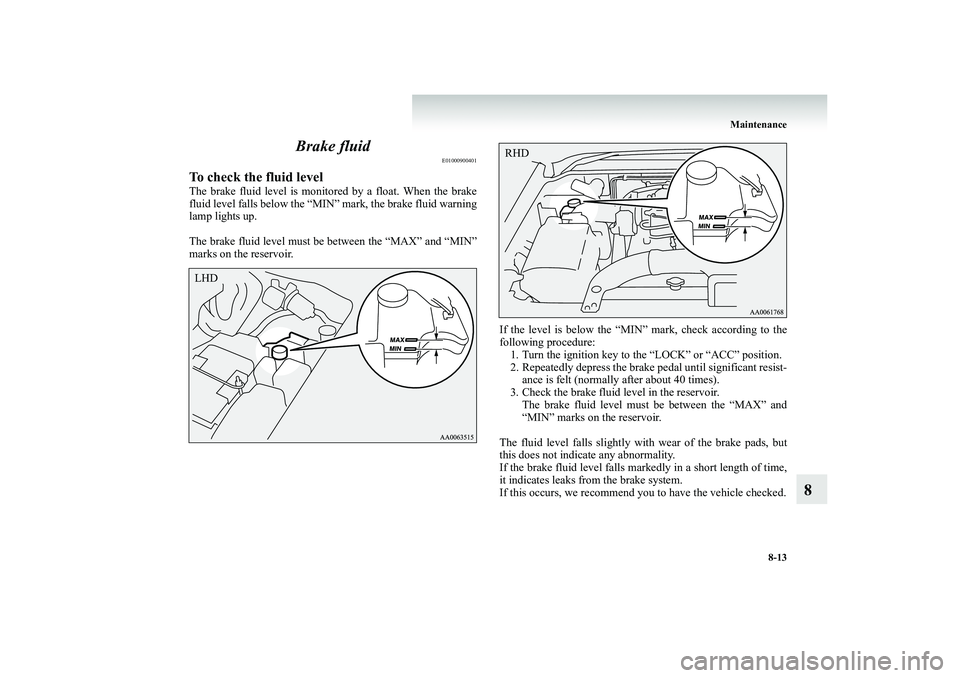
Maintenance
8-13
8
Brake fluid
E01000900401
To check the fluid levelThe brake fluid level is monito
red by a float. When the brake
fluid level falls below the “MIN” mark, the brake fluid warning lamp lights up. The brake fluid level must be
between the “MAX” and “MIN”
marks on the reservoir.
If the level is below the “MIN
” mark, check according to the
following procedure:1. Turn the ignition key to the “LOCK” or “ACC” position. 2. Repeatedly depress the brake
pedal until significant resist-
ance is felt (normally after about 40 times).
3. Check the brake fluid level in the reservoir.
The brake fluid level must be between the “MAX” and “MIN” marks on the reservoir.
The fluid level falls slightly with wear of the brake pads, but this does not indicate any abnormality.If the brake fluid level falls markedly in a short length of time, it indicates leaks fr
om the brake system.
If this occurs, we recommend yo
u to have the vehicle checked.
LHD
RHD
BK-BK2008E1ENUK.en-uk-Section11.fm Page
13 Wednesday, January 9, 2008 4:50 PM
Page 464 of 538
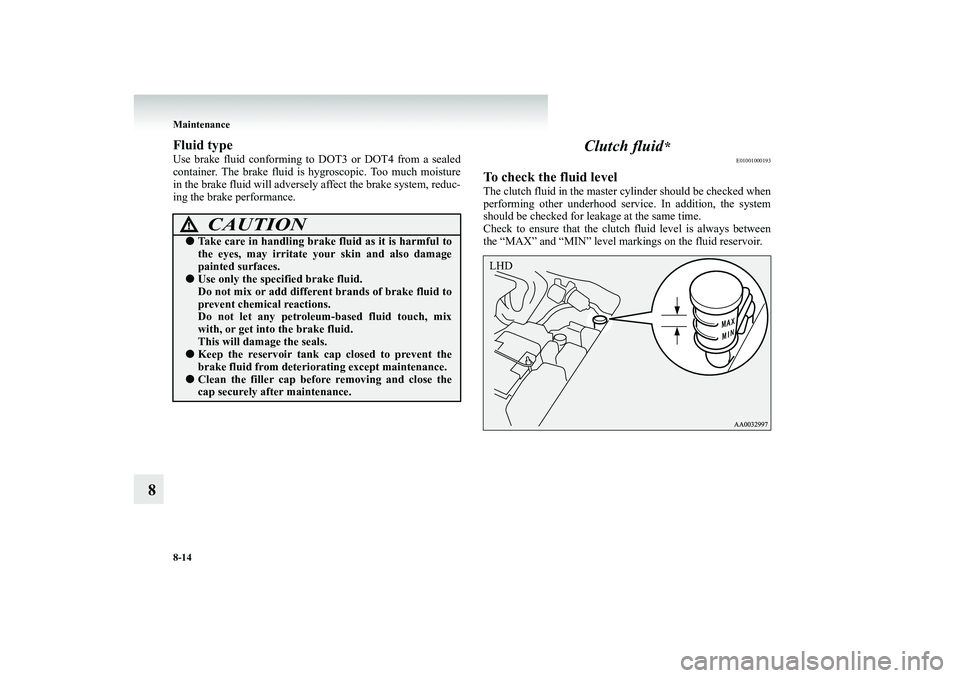
8-14 Maintenance
8
Fluid typeUse brake fluid conforming to
DOT3 or DOT4 from a sealed
container. The brake fluid is
hygroscopic. Too much moisture
in the brake fluid will adversely
affect the brake system, reduc-
ing the brake performance.
Clutch fluid
*
E01001000193
To check the fluid levelThe clutch fluid in the master cylinder should be checked whenperforming other underhood service. In addition, the system should be checked for leakage at the same time.Check to ensure that the clutch
fluid level is always between
the “MAX” and “MIN” level mark
ings on the fluid reservoir.
CAUTION
!●
Take care in handling brake fluid as it is harmful to the eyes, may irritate your skin and also damage painted surfaces.
●
Use only the specified brake fluid. Do not mix or add different brands of brake fluid to prevent chemical reactions.Do not let any petroleum-based fluid touch, mix with, or get into the brake fluid. This will damage the seals.
●
Keep the reservoir tank ca
p closed to prevent the
brake fluid from deteriorating except maintenance.
●
Clean the filler cap before
removing and close the
cap securely after maintenance.
LHD
BK-BK2008E1ENUK.en-uk-Section11.fm Page
14 Wednesday, January 9, 2008 4:50 PM
Page 465 of 538
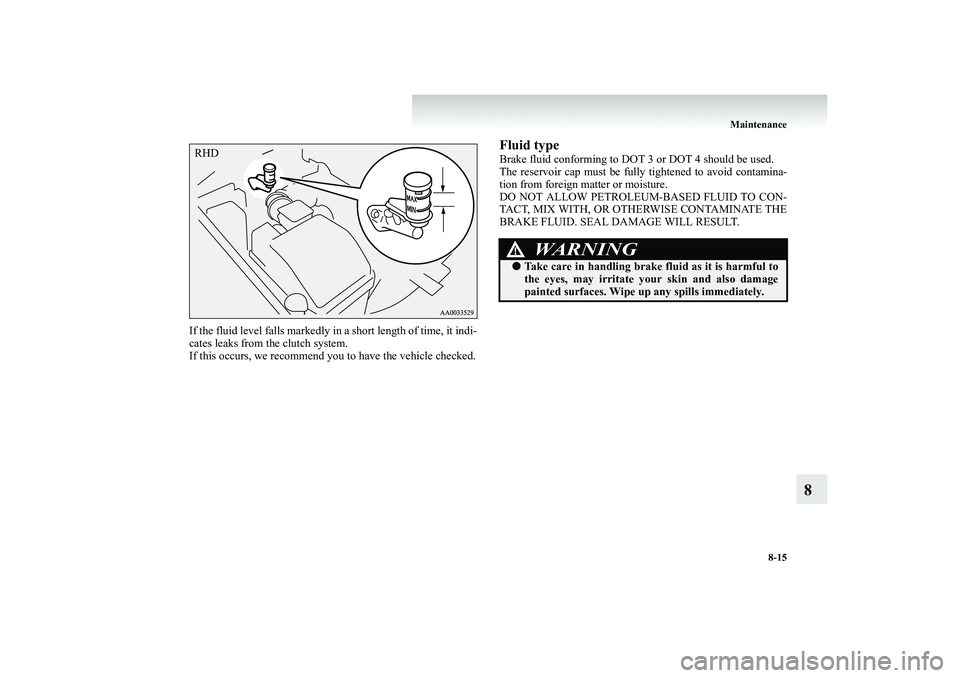
Maintenance
8-15
8
If the fluid level falls markedly in a short length of time, it indi- cates leaks from the clutch system. If this occurs, we recommend y
ou to have the vehicle checked.
Fluid typeBrake fluid conforming to DOT 3 or DOT 4 should be used. The reservoir cap must be full
y tightened to avoid contamina-
tion from foreign matter or moisture. DO NOT ALLOW PETROLEUM-BASED FLUID TO CON- TACT, MIX WITH, OR OTHERWISE CONTAMINATE THEBRAKE FLUID. SEAL DAMAGE WILL RESULT.
RHD
WARNING
!●
Take care in handling brake fluid as it is harmful to the eyes, may irritate yo
ur skin and also damage
painted surfaces. Wipe up any spills immediately.
BK-BK2008E1ENUK.en-uk-Section11.fm Page
15 Wednesday, January 9, 2008 4:50 PM
Page 466 of 538
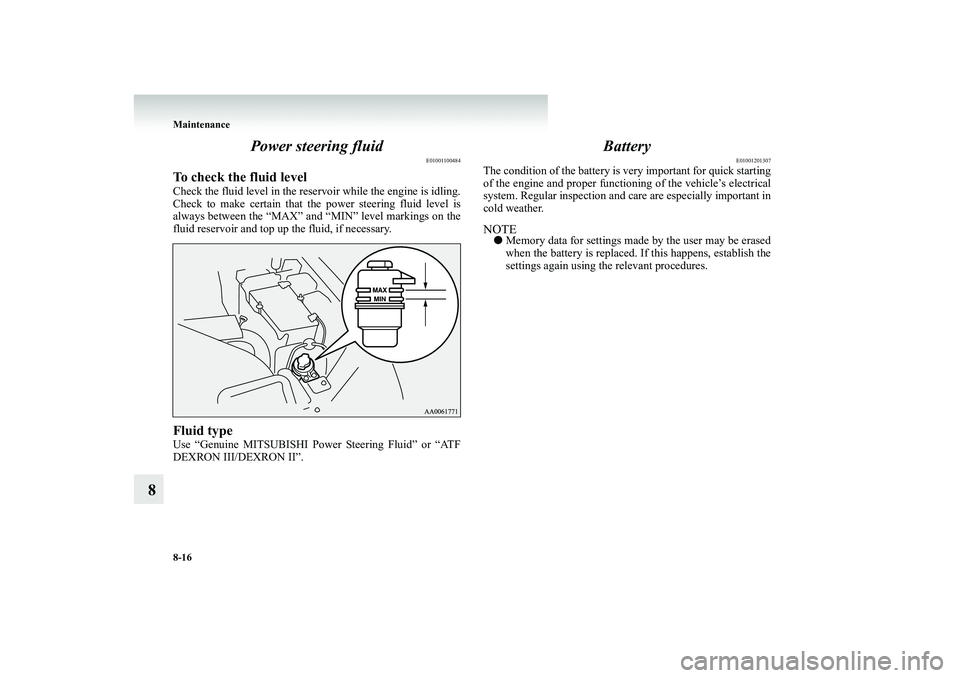
8-16 Maintenance
8
Power steering fluid
E01001100484
To check the fluid levelCheck the fluid level in the reservoir while the engine is idling. Check to make certain that the power steering fluid level is always between the “MAX” and “MIN” level markings on thefluid reservoir and top up the fluid, if necessary.Fluid typeUse “Genuine MITSUBISHI Power Steering Fluid” or “ATF DEXRON III/DEXRON II”.
Battery
E01001201307
The condition of the battery is very important for quick startingof the engine and proper functioning of the vehicle’s electrical system. Regular inspection and car
e are especially important in
cold weather.NOTE●
Memory data for settings made by the user may be erased when the battery is replaced. If
this happens,
establish the
settings again using the relevant procedures.
BK-BK2008E1ENUK.en-uk-Section11.fm Page
16 Wednesday, January 9, 2008 4:50 PM
Page 467 of 538
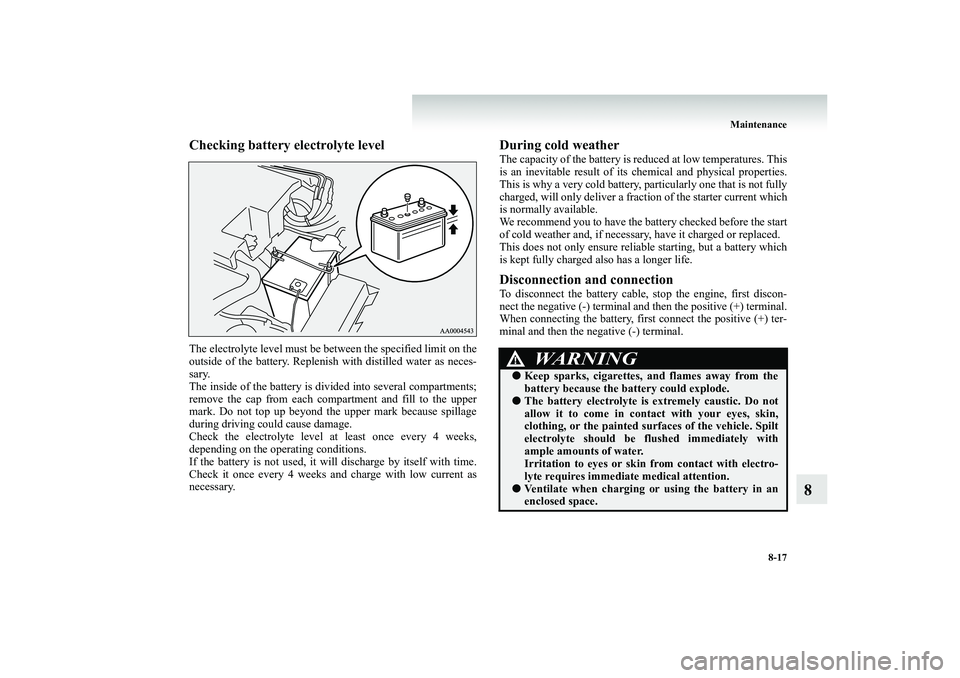
Maintenance
8-17
8
Checking battery electrolyte levelThe electrolyte level must be be
tween the specified limit on the
outside of the battery. Replenish with distilled water as neces- sary.The inside of the battery is divided into several compartments; remove the cap from each comp
artment and fill
to the upper
mark. Do not top up beyond the upper mark because spillageduring driving could cause damage. Check the electrolyte level
at least once every 4 weeks,
depending on the operating conditions.If the battery is not used, it will discharge by itself with time. Check it once every 4 weeks and charge with low current as necessary.
During cold weatherThe capacity of the battery is re
duced at low temperatures. This
is an inevitable result of its
chemical and physical properties.
This is why a very cold battery, particularly one that is not fully charged, will only deliver a fracti
on of the starter current which
is normally available.We recommend you to have the battery checked before the start of cold weather and, if necessa
ry, have it charged or replaced.
This does not only ensure reliable starting, but a battery whichis kept fully charged also has a longer life.Disconnection and connectionTo disconnect the battery cable, stop the engine, first discon- nect the negative (-) terminal a
nd then the positive (+) terminal.
When connecting the battery, fi
rst connect the positive (+) ter-
minal and then the ne
gative (-) terminal.
WARNING
!●
Keep sparks, cigarettes, and flames away from the battery because the battery could explode.
●
The battery electrolyte is
extremely caustic. Do not
allow it to come in contact with your eyes, skin,clothing, or the painted surf
aces of the vehicle. Spilt
electrolyte should be
flushed immediately with
ample amounts of water.Irritation to eyes or skin
from contact with electro-
lyte requires immediate medical attention.
●
Ventilate when charging or
using the battery in an
enclosed space.
BK-BK2008E1ENUK.en-uk-Section11.fm Page
17 Wednesday, January 9, 2008 4:50 PM
Page 468 of 538
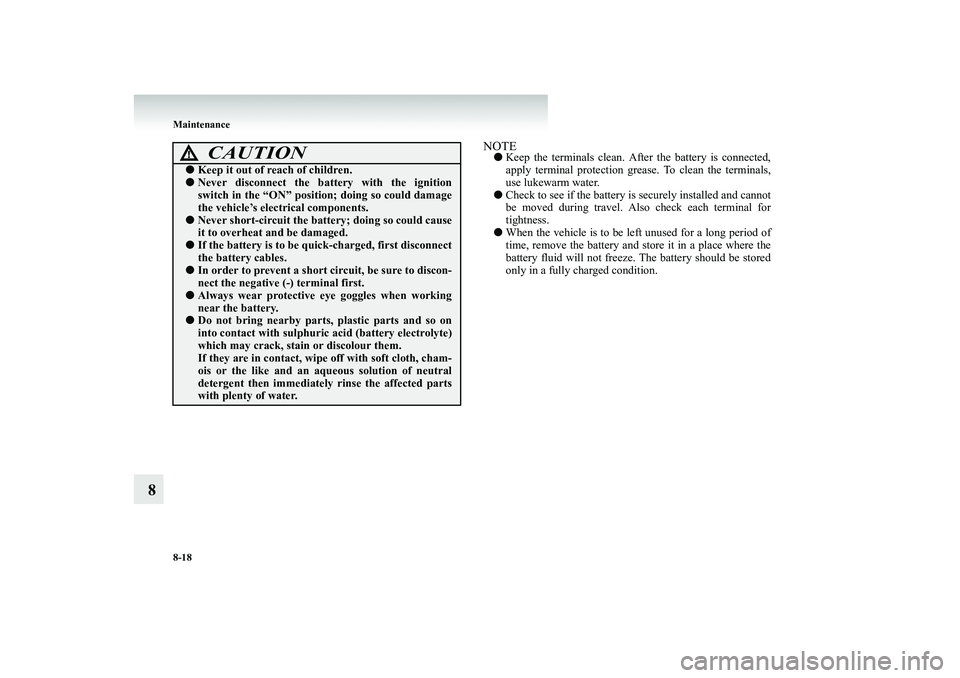
8-18 Maintenance
8
NOTE●
Keep the terminals clean. Afte
r the battery is connected,
apply terminal protection greas
e. To clean the terminals,
use lukewarm water.
●
Check to see if the battery is securely installed and cannot be moved during travel. Also check each terminal for tightness.
●
When the vehicle is to be left unused for a long period of time, remove the battery and
store it in a place where the
battery fluid will not freeze. Th
e battery should be stored
only in a fully charged condition.
CAUTION
!●
Keep it out of re
ach of children.
●
Never disconnect the ba
ttery with the ignition
switch in the “ON” position; doing so could damage the vehicle’s electrical components.
●
Never short-circuit the batt
ery; doing so could cause
it to overheat and be damaged.
●
If the battery is to be qui
ck-charged, first disconnect
the battery cables.
●
In order to prevent a short ci
rcuit, be sure to discon-
nect the negative
(-) terminal first.
●
Always wear protective eye goggles when working near the battery.
●
Do not bring nearby parts,
plastic parts and so on
into contact with sulphuric
acid (battery electrolyte)
which may crack, stain or discolour them. If they are in contact, wipe
off with soft cloth, cham-
ois or the like and an aqueous solution of neutral detergent then immediately
rinse the affected parts
with plenty of water.
BK-BK2008E1ENUK.en-uk-Section11.fm Page
18 Wednesday, January 9, 2008 4:50 PM
Page 469 of 538
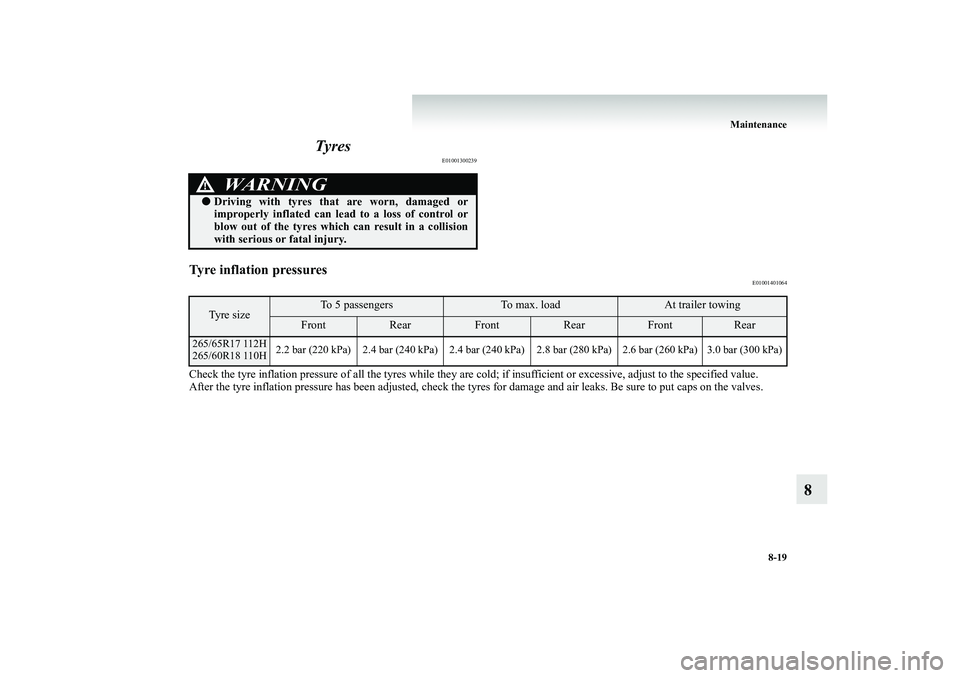
Maintenance
8-19
8
Tyres
E01001300239
Tyre inflation pressures
E01001401064
Check the tyre inflation pressure of all th
e tyres while they are cold; if insufficient
or excessive, adjust to the specified v
alue.
After the tyre inflation pressure has been
adjusted, check the tyres for damage and ai
r leaks. Be sure to put caps on the valve
s.
WARNING
!●
Driving with tyres that are worn, damaged or improperly inflated can lead
to a loss of control or
blow out of the tyres which can result in a collision with serious or fatal injury.Ty r e s i z e
To 5 passengers
To max. load
At trailer towing
Front
Rear
Front
Rear
Front
Rear
265/65R17 112H 265/60R18 110H
2.2 bar (220 kPa) 2.4 bar (240 kPa) 2.4 bar (240 kPa)
2.8 bar (280 kPa) 2.6 bar (260 kPa) 3.0 bar (300 kPa)
BK-BK2008E1ENUK.en-uk-Section11.fm Page
19 Wednesday, January 9, 2008 4:50 PM
Page 470 of 538
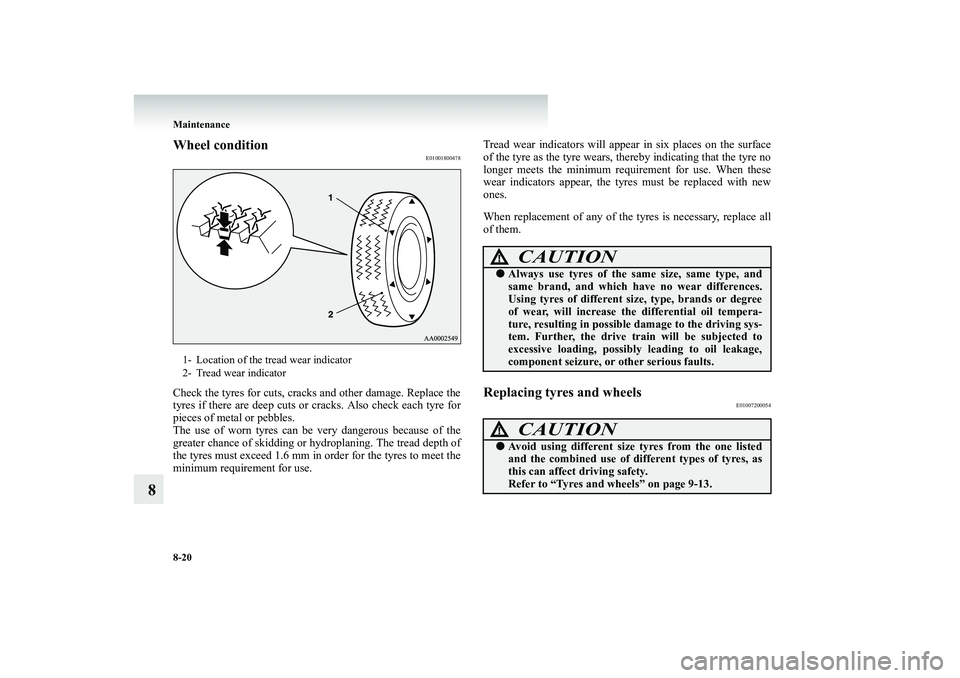
8-20 Maintenance
8
Wheel condition
E01001800478
Check the tyres for cuts, cracks and other damage. Replace the tyres if there are deep cuts or
cracks. Also check each tyre for
pieces of metal or pebbles. The use of worn tyres can be very dangerous because of thegreater chance of skidding or h
ydroplaning. The tread depth of
the tyres must exceed 1.6 mm in
order for the tyres to meet the
minimum requirement for use.
Tread wear indicators will appear in six places on the surface of the tyre as the tyre wears, thereby indicating that the tyre no longer meets the minimum requ
irement for use. When these
wear indicators appear, the tyre
s must be replaced with new
ones. When replacement of any of the tyres is necessary, replace all of them.Replacing tyres and wheels
E01007200054
1- Location of the tread wear indicator 2- Tread wear indicator
CAUTION
!●
Always use tyres of the same size, same type, and same brand, and which have no wear differences. Using tyres of different size, type, brands or degreeof wear, will increase th
e differential oil tempera-
ture, resulting in possible damage to the driving sys- tem. Further, the drive train will be subjected toexcessive loading, possibly leading to oil leakage, component seizure, or other serious faults.CAUTION
!●
Avoid using different size tyres from the one listed and the combined use of di
fferent types of tyres, as
this can affect driving safety. Refer to “Tyres and wheels” on page 9-13.
BK-BK2008E1ENUK.en-uk-Section11.fm Page
20 Wednesday, January 9, 2008 4:50 PM